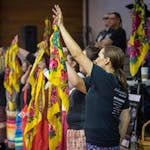A blight was sweeping the nation, killing millions of majestic trees that lined boulevards, shaded front lawns and formed a green canopy over local parks, when two Minnesota nature lovers came together with a solution.
They formed a nonprofit called Tree Trust to plant new trees, replacing those succumbing to Dutch elm disease, and to provide teenagers and young adults job training during a time when many were out of work.
Since its founding in 1976, the nonprofit has added nearly 500,000 trees and shrubs to the Twin Cities and mobilized nearly 60,000 paid interns and volunteers.
Tree Trust's hybrid mission focused on the environment and job training feels as urgent as ever, staff members say, as it faces down a new menace in emerald ash borer and a growing appetite for job training programs.
"We are planting for the future," said Karen Zumach, director of community forestry with Tree Trust.
This spring, Tree Trust planted nearly 900 trees and distributed another 1,300 through city partnerships, including the Minneapolis Tree Lottery. Nearly 250 teenagers and young adults have been awarded paid summer internships this year — outdoor positions improving parks and trails and indoor retail, office and maintenance jobs.
"It's one of the very few opportunities where teens as young as 14 years old can have a paid summer job," said Kim Lawler, Tree Trust spokeswoman. "Most of the time, it's a first job. They are learning how to show up on time, following directions, be part of a team and take initiative."
Tree Trust also operates a professionally staffed landscape business with 300 clients.
It helps people select and maintain trees and other flora — and generates money for the nonprofit, which has a $5 million annual budget. Other revenue comes from private donations and federal and state workforce grants.
Volunteer planting
On a sunny afternoon in June, volunteers gathered at Hidden Falls Regional Park on the banks of the Mississippi River in St. Paul to plant 100 trees and shrubs. The new trees will replace massive ash trees removed from the park in a partnership with the city of St. Paul.
Tree Trust's staff teaches volunteers how to plant the trees, saving the city the cost of labor.
Jim Vaughan, St. Louis Park's natural resources coordinator, has worked with Tree Trust for three decades. The nonprofit runs the city's annual tree sale, plants trees and has completed projects throughout the city's parks. Tree Trust youth crews have built boardwalks and stairs, and removed invasive buckthorn.
"They always follow through and make sure things are done right," Vaughan said. "They do employ disadvantaged youth, which is great. We support that a tremendous amount."
Tree Trust leaders hope the volunteers are inspired by what they learn and use those new skills to plant a tree in their own yards.
"Private property is the best place to plant trees and improve the canopy," said Zumach, because so much land in cities and suburbs is privately owned.
Tree Trust staff selected nearly a dozen varieties for Hidden Falls, including river birch, hackberry, black walnut and swamp white oak that will entice pollinators and thrive in that area. The volunteer planting is part of a multiyear restoration of 59 acres of forest at that park.
But there is one popular Minnesota tree the nonprofit avoids.
"I never plant a maple," Zumach said.
There's already a plethora of maples in Minnesota and many residents want to replace ash trees with maples. But doing that could make the state susceptible to another emerging pest: the invasive Asian long-horned beetle, which devours maples and is now as close as Chicago.
At the Hidden Falls event, Diana Preisen, community forestry specialist, teaches volunteers how to plant a black walnut. She shows how to prepare the roots to prevent girdling — where a tree's roots grow in a circular manner and eventually strangle the tree.
Volunteers range from a families with young children to college students, co-workers and retirees. Tree Trust also holds special planting events for children at schools.
"It's really people who care about the environment and understand the need to put more trees in the ground, especially in the time of the emerald ash borer," Lawler said.
Battling the ash borer
Emerald ash borer, an invasive species from Asia, was first discovered in North America in Michigan in 2002. It was discovered in St. Paul in 2009 and has spread from Duluth to the Minnesota-Iowa border, threatening the state's one billion ash trees.
That's what motivated college student Josh Christianson to volunteer at Hidden Falls.
"I wanted to do my part and replant the urban forest," said Christianson, a student at Minnesota State University, Mankato.
A trio of nurses from United Hospital also spent their day off planting trees.
The chance to give back in a hands-on, gets-your-hands-dirty way appealed to them, said nurse Kristin Vivian.
"This is a unique opportunity," Vivian said, "and you get to be outside."
Shannon Prather • 612-673-4804





